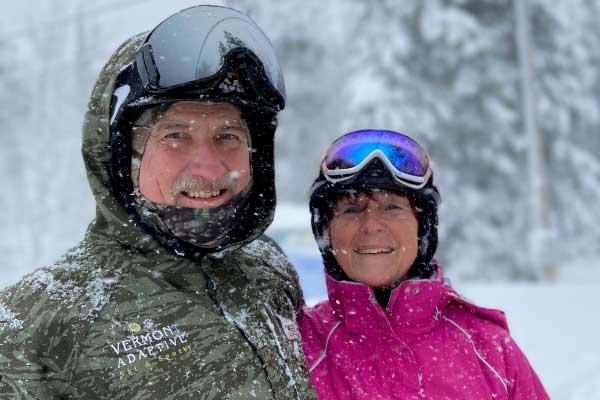
by Kelsey Price | Mar 19, 2021 | Diversity, Meet Your Neighbors, Nonprofits, Northwestern Vermont, Outdoor Recreation, Veterans
Approximately four years ago, Ray Hamilton was looking for a change. A veteran from Upstate New York, Ray moved to Vermont looking to get away from a hectic home life. When he first got here, he said that he had trouble meeting people, and he fell in with a crowd that didn’t enable him to make the healthiest choices. Soon after, he met Josh at the Department of Veteran Affairs. Josh works as the liaison between the V.A. and Vermont Adaptive.
Josh introduced Ray to our Veteran Ventures program, and Ray has been a part of the family ever since. Our Vets are a tight-knit bunch, but you would be hard-pressed to find a more welcoming group of people. On Thursdays, our Bolton group brings a potluck lunch (which heavily features our volunteer Carol Lathrop’s famous chili), and they’ll offer you a plate full of food as soon as you walk through the door. New members are always greeted with excitement, and the invitation to join is not exclusive to service members. We know that in order to support our vets, we need to support their communities, so we extend the invitation to families and partners too.
Ray’s first outing was during the summer, and he spent his Thursdays biking and hiking as a way to get out of the house. Now, we see Ray almost every week, all year long. He says that joining up with Vermont Adaptive Veteran Ventures program helped him to stop being reclusive, and get him outdoors with good friends. He attributes that to Kelly, our Program Coordinator, Misha, our Veteran Programs Specialist and Josh. He says that “they’ve done a really good job building this group into a family. I started coming in the summer, but now I come all year, all the time.”
Ray learned to snowboard with Vermont Adaptive during his first winter in Vermont. He had never touched the sport before then, and now he rips like he’s been doing it his entire life. Even more amazingly, he’s made the transition from client to volunteer instructor. Ray is using his years of experience snowboarding with Vermont Adaptive, to teach other adaptive athletes how to snowboard.
When Ray first started volunteering a year ago, he thought it would be a one-time thing in the summer. Kelly had a group of youth athletes who had visual impairments who were planning on biking, and Ray wanted to help her out. He didn’t realize how much fun he was going to have.
“You can just see these kids light up,” he said. “Because the kids I worked with are completely blind, they don’t get to go fast very often. They loved feeling the wind on their faces, and it was so fun to see their whole faces light up like that.”
Ray said that Vermont Adaptive is like his family, and that “Vermont Adaptive makes the things you think are impossible, possible. I never thought I would see kids who are blind skiing or biking, but Vermont Adaptive makes it happen.” On top of learning to snowboard, becoming a volunteer snowboarding coach, and getting outside every single week, Ray said that being with Vermont Adaptive has taught him more about himself, and given him a second chance.
This story originally appeared on Vermont Adaptive Ski & Sports. Photo courtesy Vermont Adaptive.
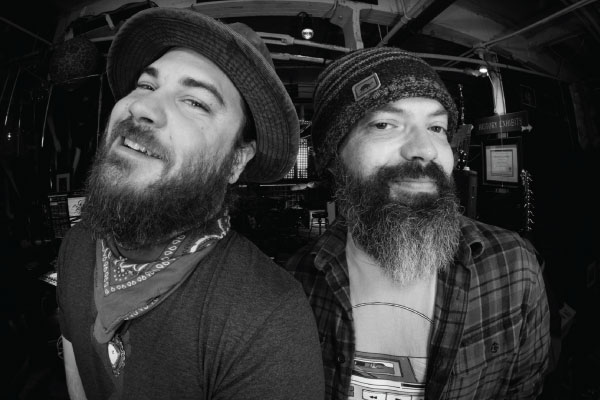
by Kelsey Price | Mar 10, 2021 | Creative Economy, Meet Your Neighbors
Jacob Green is a folk blues singer songwriter based in Vermont who recently appeared on the podcast Rocket Shop Radio Hour, which features Vermont music and artists.
Jacob Green and Nathan Michaud are musicians who tend to blend the sounds of blues, rock, and country. Together, they opened Rocket Shop with the song “When Peace Comes Back Around,” from Jacob’s new Album No End in Sight. Jacob usually plays in a bluesy style on his acoustic guitar, but Nathan’s part with the electric guitar brought a more technical and organic tone to the tracks.
Jacob considers himself a “predominantly one-man band, but about half the shows we play as a duo.” They met two years ago at a show in New Hampshire. After listening to each other’s sets, they realized that their playstyles would mesh well together. They started playing together shortly after that show.
Speaking on his own recording side-project, Nathan described his style as bluesy as well but working on something different from his previous work. This new style he described as “a reinvention of the electronic sound, with an organic tone.” He referred to the sound he’s creating as “Pink Floydish.”
Last year, Jacob had to readjust his life. Usually, he’d be playing 130-150 shows a year. With the pandemic, he was able to record and release the new album. “I got to come back to what I love doing which is kinda how it all started. The album I just put out, No End in Sight I began work on in March or April, right when this all started.”
This album was produced entirely from within his home. “I think for a lot of people if you didn’t have a home studio before, you might have one now, and if you did, maybe you’ve honed your skills a little.” In terms of the quality of the album, Jacob wanted it to sound as good as a professionally produced album. In talking about his success in achieving this goal, he said “mission accomplished.”
“I think what you get from my home studio is the sort-of happy medium between what you’d hear live versus something too overproduced or clean. It has that kind of raw, live sound.” Nathan responded with “the difference between studio and live is where the emotion and sound, everything, comes out.”
At first glance, the title of the album has a negative feel to it. Since it was released in the pandemic, it feels particularly hopeless. Jacob’s idea of the title effectively counters that feeling. “It’s also like saying, ‘we can be limitless in whatever we choose.’ In some ways we’re way too extreme; we’re too positive or too negative. The point is to recognize that. Hearing the phrase ‘no end in sight’ can seem kind of negative, but it’s more about perspective.”
In looking ahead, Jacob and Nathan have a few shows scheduled for the summer, and they should be hearing from other venues in the next month or so. After this experience with making the album, Jacob hopes to be able to be recognized for more of his original music, rather than being a cover band. “When you play as many shows as I’m used to, all this time off has given me this perspective to play more of my original stuff at my future shows.”
Jacob can be found online at his website, Facebook, Instagram, and Youtube. Nathan’s music is on Bandcamp.
Text by Phil Franklin.
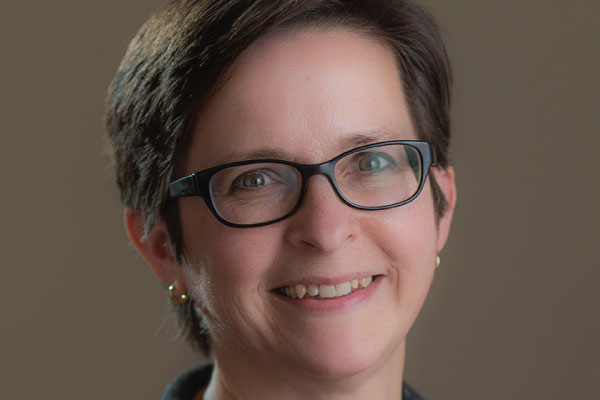
by Kelsey Price | Mar 8, 2021 | Central Vermont, Creative Economy, Diversity
YOUR NAME and TITLE: Elise Brunelle, Executive Director
YOUR ORGANIZATION: Vermont Symphony Orchestra
YEAR YOU JOINED ORGANIZATION: 2020
MONTH/YEAR YOU WERE APPOINTED TO CURRENT POSITION: August 2020
What makes you hopeful for the future?
Significant collaboration and sharing of ideas amongst artists and arts organizations. Willingness to embrace the screen as a distribution channel—which certainly helps broaden our audience reach. It also allows our music to reach those who cannot afford to buy a ticket to a live performance, or who have a physical barrier to accessing live venues.
What’s the most challenging part of your work currently?
Managing expectations—when will we produce content? Why are other peer orchestras around the country doing more work?
How have you changed as a leader in the last six months?
I’ve realized how advocacy for the arts sector as a whole should be a top priority in everyone’s job description. We can also learn a lot from for-profit business models, marketing, and distribution. I am learning to start by asking what people want and how our organization can provide value to their community. Most of all, recognizing Vermont is full of excellent artists and there is genuine understanding of the value of art in this state.
What are you prioritizing?
Continuous and clear communication with our musicians, artistic partners, donors, and peers. Safety of our staff, musicians, and audience. Identifying new sources of income to replace the eventual end of Covid relief. Being a can-do, flexible arts organization that serves the entire state.
How do you see your relationship with your constituents evolving over the next five years?
It will broaden and diversify to include digital audiences around the world (while retaining live audiences when it is safe to do so).
How can cultural institutions and organizations participate in the current call for creating a more diverse, equitable, and inclusive world?
Let’s mainstream diversity, equity, and inclusion in our day-to-day operations. Ask ourselves, does our organization’s spending power reach BIPOC-owned businesses? Do our publicity efforts include BIPOC-owned or -focused media? Do we have an established board committee, with staff involvement, to establish and reach targets in these areas? Have we asked our existing or potential BIPOC audiences how we can best engage with them? Start somewhere, and see it through. Address equity, diversity, and inclusion as seriously as you do your strategic plan, cash flow, and artistic output.
What are some lessons learned or advice that you can share with other organizations who are grappling with the multi-faceted challenges of this time?
We will return to live events, but the future is online and there’s huge competition. Focus on what’s unique about your organization’s art and make noise about what you do. Try the untested, be bold, and work with others. Rethink how many things you need to produce, i.e., number of concerts, exhibitions, publications vs. how well you produce and share them. Invest money and time in creating great online content. Most of all, “do what you can, with what you have, where you are” and find contentment in that.
This story by the Vermont Arts Council originally appeared at https://www.vermontartscouncil.org/blog/steering-the-ship-a-qa-with-vermonts-cultural-leaders-elise-brunelle/
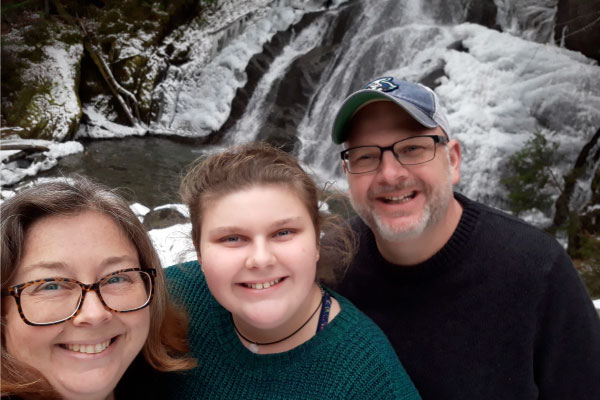
by Kelsey Price | Mar 5, 2021 | Meet Your Neighbors, Northeast Kingdom, Relocation Incentives, Relocation Testimonials, Vermonting
Although their lives in Florida were “a constant vacation,” Skye Devarney and her husband knew ultimately, they wanted their daughter, 12, to grow up in Vermont.
Devarney’s husband has roots in St. Albans, and she grew up in New Hampshire. The couple married in New Hampshire and moved to Florida, staying for five years before realizing it was time to pursue their Vermont dreams.
Devarney, 43, and her family have settled in Brownington, in Vermont’s beautiful, rural Northeast Kingdom. As they searched online for information about moving, they were surprised to learn help was available to them in the form of a Remote Worker Grant Program.
Since settling in, “We have felt very welcomed. Brownington is a wonderful small town with great people. Our neighbors have been very helpful and supportive. We have one neighbor who has tilled our garden for us several times. I am also working at Brownington Central School. The people I work with are kind, helpful, and very welcoming,” Devarney said.
The couple found jobs before arriving in Vermont.
“I started working as an 5-8 ELA teacher at Brownington Central School in January 2020 and am still there. My husband accepted a position at Bradford Elementary School as a Behavior Specialist. However, he has been working at Charleston Elementary School as a math teacher since Fall 2020,” Devarney said.
Moving has benefited their family exactly as Devarney hoped it would.
“Our daughter loves life in Vermont. She is happy to be closer to her family. She also loves rural life in the country. She loves being able to play outside and she and her father raised a wonderful vegetable garden this summer. She also loves her school. It is much smaller and more focused on social emotional learning than her school in Florida was. She feels less stress and pressure than she did in Florida.”
Devarney said her family would recommend others consider moving to Vermont, with the understanding that self-sufficiency is vital here, more so than in urban areas.
“In Florida, we had every restaurant and store we could imagine within a mile from us. We were one hour from all the theme parks. We lived on the beaches and life was a constant vacation. Here, we have to rely on deliveries and making our own entertainment. But we love it! Life is simpler and we are much happier… Although the work is harder (taking care of the land, heating the house, etc.), we feel a sense of simplicity in taking care of ourselves. Life here is less complicated.”
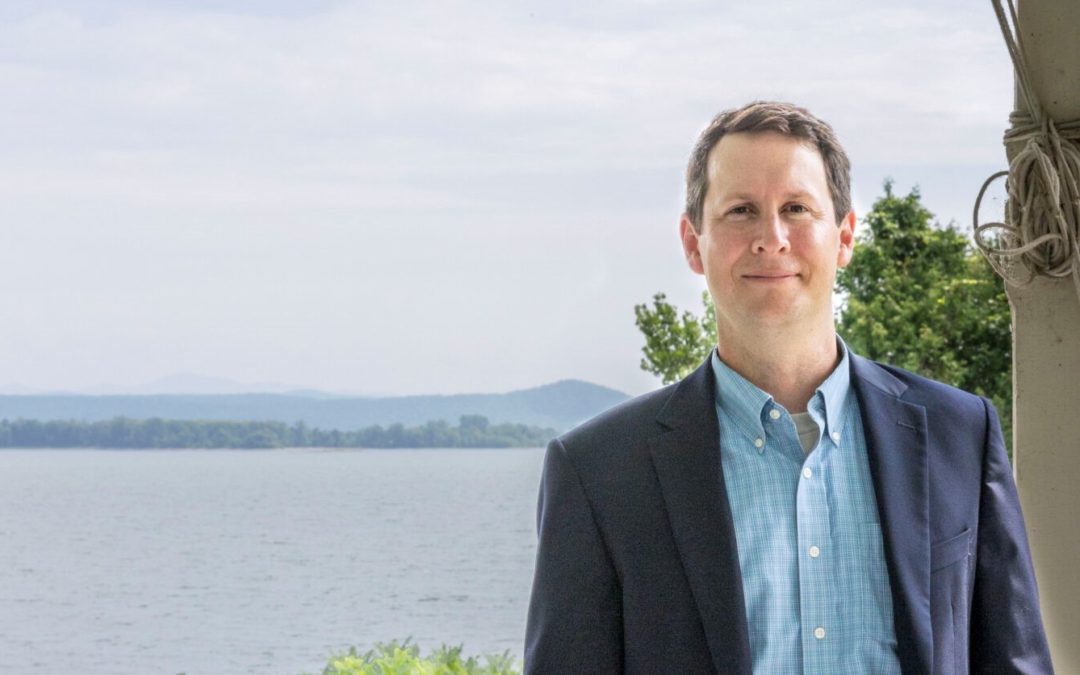
by Kelsey Price | Feb 16, 2021 | Communities, Creative Economy, Northwestern Vermont
YOUR NAME and TITLE: Ben Doyle, President
YOUR ORGANIZATION: Preservation Trust of Vermont
YEAR YOU JOINED ORGANIZATION: 2020
MONTH/YEAR YOU WERE APPOINTED TO CURRENT POSITION: October 2020
What makes you hopeful for the future?
The past. Vermont sometimes has a reputation of being frozen in time, but I don’t think that story holds up. Vermont, and rural America in general, has always been a dynamic place that has adapted both economically and culturally to the needs of the moment. At PTV, we work with communities to navigate and embrace change while preserving the buildings and places that manifest their values. Spaces where Vermonters (including new ones) can come together to build a shared community are particularly hopeful.
I’m also inspired by kids and pets wandering into Zoom calls at work.
What’s the most challenging part of your work currently?
Not being out in the field. The best part of this job is meeting with people in the buildings and communities they love. We tour old barns, crawl around in basements, visit over coffee at a general store. I don’t think there’s anything I enjoy more than visiting with folks at a spaghetti supper in a small town and hearing about what’s important to them. While it’s been great to find new ways to meet with people on Zoom, in-person connection is something I think all of us are craving.
How have you changed as a leader in the last six months?
I think everyone’s horizons have broadened. I don’t hear too many people saying “when we get back to normal” anymore. There is a recognition that parts of our world need to change and that the circle of who makes decisions in a community needs to widen. I’ve always tried to listen well, but that’s something I plan to double down on moving forward.
What are you prioritizing?
Supporting Vermont’s historic villages and downtowns. These are the places where Vermonters come together to meet their neighbors, engage in commerce, participate in civic life. The pandemic is challenging them in a variety of ways: by preventing us from gathering or by accelerating online shopping trends that export local wealth. Our villages and downtowns are where we’ve invested in infrastructure, both physical and cultural, and so anything we can do to preserve that investment and leverage it coming out of the pandemic is critically important.
How do you see your relationship with your constituents evolving over the next five years?
PTV is committed to preserving the essential character of Vermont. I’m excited and fascinated by the questions that work prompts all of us to ask. What is it about this place that we love? How do the buildings we care for tell the story of who we are or who we aspire to be? I believe in the coming years many people will find their way to Vermont, by chance or by choice, and so the conversation with our constituents needs to be expansive and celebrate the dynamism that will come with it.
How can cultural institutions and organizations participate in the current call for creating a more diverse, equitable, and inclusive world?
Any kind of public or philanthropic investment is grounded in values and reflects a point of view. I think cultural institutions are uniquely positioned to help surface those values and deeply examine them. If we start with the aspiration that every Vermonter should feel welcome and have the ability to equitably participate in the life of their community, then the stories we tell, the art we celebrate, the buildings we save, should honor that ideal.
What are some lessons learned or advice that you can share with other organizations who are grappling with the multi-faceted challenges of this time?
I love Flannery O’Connor’s idea that “everything that rises must converge.” The experience of the pandemic has revealed the extent to which “multi-faceted challenges” are connected. That’s why I’m inspired by cultural organizations thinking about food access. Economic development agencies thinking about equity. Historic preservation that thinks about the future. The more we approach our challenges as connected ones, the more successful we will be in finding solutions.
Anything else that you’d like to add?
I’m continually inspired by the local leadership I see everyday. People who don’t necessarily see themselves as leaders or changemakers, but are working hard to help their neighbors and create a community of care. It’s these people, performing individual acts of service and kindness, who make Vermont a wonderful place to call home.
This story by the Vermont Arts Council originally appeared at https://www.vermontartscouncil.org/blog/steering-the-ship-a-qa-with-vermonts-cultural-leaders-ben-doyle/. Photo by Jude Domski.







